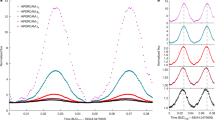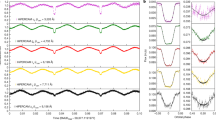Abstract
Cataclysmic variables (classical novae and dwarf novae) are binary star systems in which a red dwarf transfers hydrogen-rich matter, by way of an accretion disk, to its white dwarf companion1. In dwarf novae, an instability2 is believed to episodically dump much of the accretion disk onto the white dwarf. The liberation of gravitational potential energy then brightens these systems by up to 100-fold every few weeks or months2. Thermonuclear-powered eruptions thousands of times more luminous3,4 occur in classical novae5, accompanied by significant mass ejection6 and formation of clearly visible shells7,8 from the ejected material. Theory predicts that the white dwarfs in all dwarf novae must eventually accrete enough mass to undergo classical nova eruptions9. Here we report a shell, an order of magnitude more extended than those detected around many classical novae, surrounding the prototypical dwarf nova Z Camelopardalis. The derived shell mass matches that of classical novae, and is inconsistent with the mass expected from a dwarf nova wind or a planetary nebula. The shell observationally links the prototypical dwarf nova Z Camelopardalis with an ancient nova eruption and the classical nova process.
This is a preview of subscription content, access via your institution
Access options
Subscribe to this journal
Receive 51 print issues and online access
$199.00 per year
only $3.90 per issue
Buy this article
- Purchase on Springer Link
- Instant access to full article PDF
Prices may be subject to local taxes which are calculated during checkout




Similar content being viewed by others
References
Warner, B. Cataclysmic Variable Stars 7–11 269 (Cambridge Univ. Press, Cambridge, UK, 1995)
Osaki, Y. An accretion model for the outbursts of U Geminorum stars. Publ. Astron. Soc. Jpn 26, 429–436 (1974)
Lundmark, K. Some facts and suggestions concerning novæ. Publ. Astron. Soc. Pacif. 35, 95–117 (1923)
Hubble, E. P. A spiral nebula as a stellar system, Messier 31. Astrophys. J. 69, 103–158 (1929)
Yaron, O., Prialnik, D., Shara, M. & Kovetz, A. An extended grid of nova models. II. The parameter space of nova outbursts. Astrophys. J. 623, 398–410 (2005)
Payne-Gaposhkin, C. The Galactic Novae 53–70 (Interscience Publishers, New York, 1957)
Wade, R. A. in Physics of Classical Novae (eds Cassatella, A. & Viotti, R.) 179–187 (Proc. IAU Coll. 122, Springer, Berlin, 1990)
Downes, R. A. & Duerbeck, H. W. Optical imaging of nova shells and the maximum magnitude-rate of decline relationship. Astron. J. 120, 2007–2037 (2000)
Shara, M., Livio, M., Moffat, A. & Orio, M. Do novae hibernate during most of the millennia between eruptions? Links between dwarf and classical novae, and implications for the space densities and evolution of cataclysmic binaries. Astrophys. J. 311, 163–171 (1986)
Thorstensten, J. R. Parallaxes and distance estimates for 14 cataclysmic variable stars. Astron. J. 126, 3017–3029 (2003)
Mattei, J. A., Waagen, E. O., Oppenheimer, B. D. & Foster, E. G. Z Camelopardalis Light Curves 1927–1995 (Am. Assoc. Var. Star Observers Monograph, Cambridge, Massachusetts, 1996)
Robinson, E. L. Detection of mass loss from the dwarf nova Z Camelopardalis. Astrophys. J. 186, 347–356 (1973)
Szkody, P. & Mateo, M. Z. Camelopardalis: Outburst P Cygni profiles and quiescent continuum. Astrophys. J. 301, 286–296 (1986)
Baskill, D. S., Wheatley, P. J. & Osborne, J. P. ASCA X-ray observations of the disc wind in the dwarf nova Z Camelopardalis. Mon. Not. R. Astron. Soc. 328, 71–78 (2001)
Martin, D. C. et al. The Galaxy Evolution Explorer: A space ultraviolet survey mission. Astrophys. J. 619, L1–L4 (2005)
Bode, M. F., O’Brien, T. J. & Simpson, M. Echoes of an explosive past: Solving the mystery of the first superluminal source. Astrophys. J. 600, L63–L66 (2004)
Sabbadin, F. & D’Odorico, S. Spectroscopic observations of the supernova remnant candidates 3C 400.2 and S91. Astron. Astrophys. 49, 443–445 (1976)
Dopita, M. Optical emission from shock waves. Astrophys. J. Suppl. Ser. 33, 437–449 (1977)
Knigge, C., Long, K. S., Blair, W. P. & Wade, R. A. Disks, winds, and veiling curtains: Dissecting the ultraviolet spectrum of the dwarf nova Z Camelopardalis in outburst. Astrophys. J. 476, 291–310 (1997)
Blocker, T. Stellar evolution of low- and intermediate-mass stars II. Post-AGB evolution. Astron. Astrophys. 299, 755–769 (1995)
Høg, E. et al. The Tycho-2 catalogue of the 2.5 million brightest stars. Astron. Astrophys. 355, L27–L30 (2000)
The Vela supernova remnant. 〈http://www.aao.gov.au/images/captions/uks002.html〉 (2002)
Shara, M. M. A theoretical explanation of the absolute magnitude-decline time MB -t3 relationship for classical novae. Astrophys. J. 243, 926–934 (1981)
Simon, V. Dramatic change of the recurrence time and outburst parameters of the intermediate polar GK Persei. Astron. Astrophys. 382, 910–920 (2002)
Osterbrock, D. E. et al. Night-sky high-resolution spectral atlas of OH and O2 emission lines for echelle spectrograph wavelength calibration. Publ. Astron. Soc. Pacif. 108, 277–308 (1996)
Acknowledgements
This work was supported by the National Aeronautics and Space Administration. Telescope time at the Kitt Peak National Observatory, Lick Observatory and the Palomar Observatory is gratefully acknowledged. Kitt Peak National Observatory of the National Optical Astronomy Observatory is operated by the Association of Universities for Research in Astronomy, Inc. (AURA) under cooperative agreement with the National Science Foundation.
Author information
Authors and Affiliations
Corresponding author
Ethics declarations
Competing interests
Reprints and permissions information is available at www.nature.com/reprints. The authors declare no competing financial interests.
Rights and permissions
About this article
Cite this article
Shara, M., Martin, C., Seibert, M. et al. An ancient nova shell around the dwarf nova Z Camelopardalis. Nature 446, 159–162 (2007). https://doi.org/10.1038/nature05576
Received:
Accepted:
Issue Date:
DOI: https://doi.org/10.1038/nature05576
This article is cited by
-
A unified theory of cataclysmic variable evolution from feedback-dominated numerical simulations
Nature Astronomy (2020)
-
Observations of galactic and extragalactic novae
The Astronomy and Astrophysics Review (2020)
-
A recurrent nova super-remnant in the Andromeda galaxy
Nature (2019)
-
Proper-motion age dating of the progeny of Nova Scorpii AD 1437
Nature (2017)
-
The awakening of a classical nova from hibernation
Nature (2016)
Comments
By submitting a comment you agree to abide by our Terms and Community Guidelines. If you find something abusive or that does not comply with our terms or guidelines please flag it as inappropriate.



